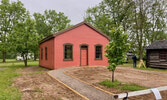Blyth's Rutledge honoured provincially for work on historic London-area church
BY SHAWN LOUGHLIN
Last month, Blyth-based architect John Rutledge won the Peter Stokes Restoration Award for a small-scale building, one of the Heritage Awards handed out annually by the Architectural Conservancy of Ontario.
The honour comes for Rutledge’s work on the African Methodist Episcopal Church, which has, over time, also been known as the Fugitive Slave Chapel. The building now sits at Fanshawe Pioneer Village and it represents many years of work that Rutledge describes as being somewhat of a rollercoaster that involved the hard work of many dedicated volunteers, committees and boards to get to where it is today.
The building dates back to 1848 and 1849 when the Black Congregation of the African Methodist Episcopal Church built what Rutledge calls a “humble place of worship” on Thames Street in London, Ontario.
During the early years of the church, it became part of the Underground Railroad as Black Americans moved north to flee slavery. In the 1920s, the congregation sold the church and it became a residence for decades when, in the early 2000s, the owners at the time expressed a desire to demolish the building.
Then, in 2014 and 2015, a group of volunteers who knew of the building’s historical significance arranged to have the building moved to, what was at the time, an empty lot on Grey Street in London. There it would sit as a “parent” moving next to its “child”, as it sat next to Beth Emmanuel Church.
At the time, there was an idea to restore, renovate and expand the building to create a community centre and museum of London’s Black history, though that plan was put on hold and never revisited.
In the ensuing years, Rutledge says several “rifts” developed over a number of things, including governance, ownership, purpose and the historic value of the building, which would eventually be tarped and closed to anyone for six years.
Thankfully, Rutledge said, there were some who kept the restoration of the building close to their hearts and, in November of 2022, the building was moved again - this time to Fanshawe Pioneer Village, where it remains today.
It was the first time in over 15 years that Fanshawe Pioneer Village had welcomed a new building and, Rutledge says, many of the buildings there represented London’s “White, Anglo-Saxon Protestant” history, while this new addition would tell a different story and reflect the diversity of London, both then and now.
With that move, Rutledge says, it became a pure, historic restoration, rather than what was discussed in those earlier plans of a community centre and museum. Fanshawe Pioneer Village representatives, however, went ahead with the installation of insulation and some electric lighting. With Black History Month in February, these changes would allow for the building to play host to special events in what is historically one of the coldest months of the year in Southwestern Ontario.
After the building was moved, restoration work began in January of 2023. It included work on the roof, windows, window and door trim and more, in addition to painting the exterior a “rusty, terracotta reddish colour”, according to Rutledge.
Rutledge’s nomination for the award included several comments from people who were involved with the project along the way, including Dawn Miskelly, executive director of the London and Middlesex Heritage Museum, Christina Lord of the Chapel Project Steering Committee and Carl Cadogan, the chair of the London Black History Co-ordinating Committee.
“The mission of the London Black History Co-ordinating Committee is to increase the awareness and profile of the diverse Black community of London and our vision is that all Londoners are aware of and understand the important and vital role that members of the Black community have played in building the community of London,” Cadogan is quoted as saying for the nomination. “And having been involved in the work of saving the ‘Fugitive Slave Chapel’ for almost 15 years, we are excited to be part of the move of the chapel to Fanshawe Pioneer Village. As one of the oldest surviving buildings that speaks to London’s Black history, we are excited to partner with Fanshawe Pioneer Village to create a Black presence in the village. This partnership broadens our collective involvement in the ‘pioneering history.’”
Cadogan went on to say, “The work that John Rutledge did to move the chapel to its restoration stage has been critical in our work with all of our community partners in developing programming and interpretation that is reflective of London’s involvement in the Underground Railroad, as well as to commemorate and recognize the region’s diverse Black histories.”
Rutledge, in speaking with The Citizen, said he felt very honoured to be recognized in this way, though the honour also belonged to all of the dedicated volunteers who have worked on the chapel over the years and refused to let its momentum fade as an important historical building. Working as an architect for over 30 years, Rutledge said, being honoured with such a prestigious award is pretty amazing.
“The Fugitive Slave Chapel, now known as the African Methodist Episcopal Church (its original name), provides a valuable aspect of London’s Black history to Fanshawe Pioneer Village,” said Lord in the nomination documents. “The fact that it will inform other programming at the village is essential for visitors, particularly the younger generations, to get a more fulsome perspective of the rich history of our region.
“John Rutledge and the various teams he has served with have made the chapel come back to life and it has been heartwarming to watch this unfold.”
The award collected by Rutledge on Oct. 12 in Toronto was one of just a dozen awards handed out by the Architectural Conservancy of Ontario every year.
“The addition of the building known as the Fugitive Slave Chapel to Fanshawe Pioneer Village aligns well with our museum’s mission to connect our communities by remembering, sharing and celebrating local histories. As likely the oldest surviving building that speaks to London’s Black history, it provides a built heritage presence in the village and allows us to include more voices in the story we share,” said Miskelly in the nomination.










